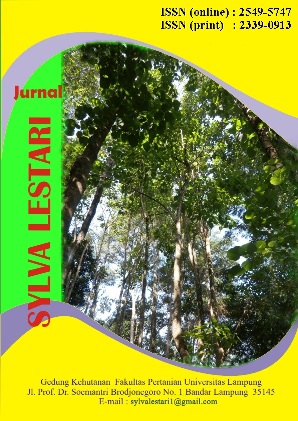Perilaku Menggaram Gajah Sumatera (Elephas Maximus Sumatranus) Dan Kandungan Garam Mineral Pada Saltlicks Di Resort Pemerihan Taman Nasional Bukit Barisan Selatan
DOI:
https://doi.org/10.23960/jsl23123-130 Abstract View: 1247
Abstract View: 1247
Abstract
Sumatran elephant (Elephas maximus sumatranus) requires mineral salts to the body's metabolic processes which can be obtained from the vegetation feed. Mineral deficiencies in plants causes elephants seek other alternative sources such as lick and eat soil that contains salt. This research was done due to lack information about salting behavior and mineral salt content in the saltlicks. The aims of these research were to analyze the salting behavior of Sumatran elephants and to find out mineral salt content of the soil in the saltlicks. The research was done on January 2015 in TNBBS Pemerihan Resort. The research methods of salting behavior used descriptive analysis, mineral content analysis used Microwafe Plasma–Atomic Emission Spectrometer (MP-AES) supported by key person interview and literature studies. The results of this study indicate that salting behavior of Yongki (0,08%) of total daily behavior, the source of salt obtained from soil and mud on riparian, cliffs, primary forest, secondary forest and meadow. Salting was done by taking directly using trunk and put into the mouth. The results of the analyzed of mineral salt content in the soil there are Ca (0.190%), Mg (0,013%), K (0.158%). In the mud Ca (0,323%), Mg (0.405%) and K (0.233%). Elephant more prefer to the mud because mineral content in the mud is higher than soil.
Keywords: Sumatran elephants, salting behavior, saltlicks, mineral salt content of the soil, Bukit Barisan Selatan National Park
Downloads
Downloads
Published
Issue
Section
License
Authors retain copyright and grant the journal right of first publication with the work simultaneously licensed under a Creative Commons Attribution-NonCommercial 4.0 Licence that allows others to share the work with an acknowledgement of the work's authorship and initial publication in this journal.
Authors are able to enter into separate, additional contractual arrangements for the non-exclusive distribution of the journal's published version of the work (e.g., post it to an institutional repository or publish it in a book), with an acknowledgement of its initial publication in this journal.
Authors are permitted and encouraged to post their work online (e.g., in institutional repositories or on their website) prior to and during the submission process, as it can lead to productive exchanges, as well as earlier and greater citation of published work (See The Effect of Open Access).

